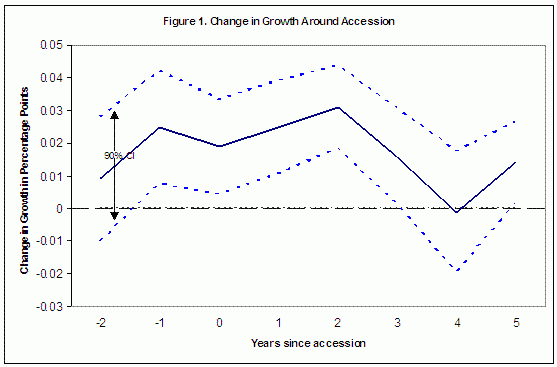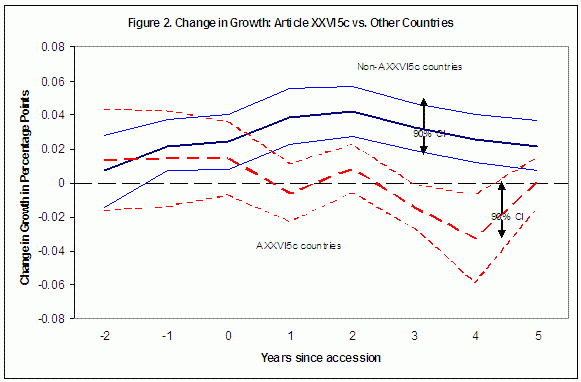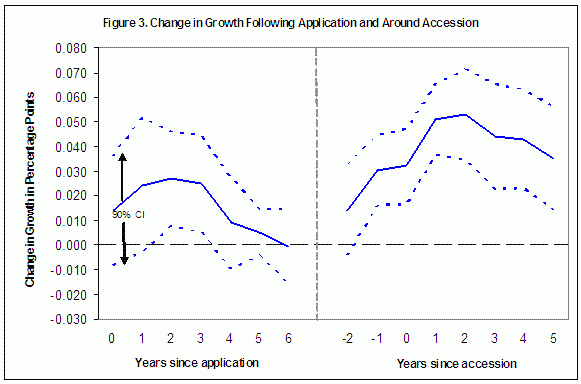Pro-growth reforms can be “locked in” through legally binding external commitments in WTO accessions, free trade agreements, or IMF and World Bank loans. Once embedded in an international treaty, a reform programme carries higher costs of reversal, which makes it less likely to be undone unilaterally, and hence becomes more appealing to investors. Thus, for all political difficulties involved, agreements that bring pro-growth reform may be thought as "beneficial medicine with a bitter aftertaste".
However, the value of such external commitments is not a forgone conclusion. In fact, some economists are sceptical about it. Rose (2004) considers WTO commitments to be irrelevant to foster trade. Barro and Lee (2005) attack IMF conditionality for failing to enhance countries' growth prospect. Jawara and Kwa (2003) denounce the loss of “policy space” implied by external commitments. In sum, all these authors consider the medicine a placebo at best or, at worst, poisonous.
In recent research (Tang and Wei 2008), we conclude that WTO/GATT accessions between 1990 and 2001 lifted acceding countries' growth trajectory.
The empirical challenge
Determining the impact of WTO accession on growth is difficult. First, WTO accession means different things to different nations. Some involve long negotiations and a lengthy list of demands on the acceding nations (e.g. China). Others are much less demanding. Moreover, accession could have a two-way relationship with growth. It could be that WTO accession become more attractive to nations that are or expect to be growing fast – in a sense, the growth could be causing the accession. Therefore, isolating a causal effect of WTO accessions on growth is challenging.
To get around these problems, we carefully model a number of economic and institutional features of the WTO accession process. We consider accessions with and without extensive reforms, time gaps between application and actual accession, self-selection effects, as well as differences in applicants’ governance quality. Taken together these features allow us to more precisely estimate the impact of WTO accession on growth rates.
A picture is worth a thousand words
Figure 1 plots the trajectories of the changes in growth for all the accession countries relative to the control group (dotted lines show the 90% confidence interval). In the year before accession, countries are growing about 2.4 percentage points faster than before, relative to other countries. The growth rates stay high in the four subsequent years. Note that WTO accession leads to one-off increase in the income level (though with a transitions period of several years), without necessarily a permanent effect on the growth rate.
Playing favours: Different accession criteria due to Article XXVI5(c)
Figure 1 masks a substantial degree of heterogeneity among countries in terms of their accession procedures. Up to the end of 1994, a subset of countries was eligible to join the GATT under Article XXVI 5(c) without having to promise reforms – if their former colonisers were GATT members by the time of their own independence. By contrast, the rest of developing countries underwent rigorous negotiations. We test if the impact of WTO accession on growth rates is greater for the latter group. We use dummies to identify 18 countries in our sample that invoked GATT Article XXVI 5(c) and were subjected to less rigorous accession procedures. Note that both groups are still analysed relative to the control group.
Figure 2 shows that non-Article XXVI 5(c) countries grew faster than both Article XXVI 5(c) countries and the sample as whole (as shown in Figure 1). Moreover, the effect of more rigorous accession on growth seems longer-lasting, with positive impact even beyond the fifth year after accession. Also, non-Article XXVI 5(c) countries invested more of their output than before relative to Article XXVI 5(c) countries or the control group.
Mind the gap: Delays between applications and accessions
It is possible that governments apply for WTO/GATT membership only when they are ready to pursue pro-growth policies. Under this scenario, WTO membership doesn’t raise growth rates even though the two can be observed to go hand-in-hand. How do we detect any growth-promoting effect of WTO membership beyond this self-selection by pro-growth governments? During 1995-2001, the median time between application to the WTO and actual WTO accessions was just about 6 years. We exploit this long and variable gap between the date of application and the actual accession to isolate the effect of accession-induced reforms from reforms that a government wants to implement anyways. Thus we can claim that previous results are not influenced by the fact that pro-growth governments may be more likely to apply for WTO accession. Using the benchmark setting of non-Article XXVI 5(c) accession countries vs. control group, we test for a distinctive growth spurt after actual accession, which we believe corresponds to the WTO accession effect isolated from “government-type” effect.
As shown in left-hand side panel in Figure 3, there is indeed an increase in the growth rate in the two to four years after application. This might be associated with the government’s pursuit of various reforms that might or might not be related to WTO/GATT accession. The right hand-side panel in Figure 3 shows that, as countries approach the time of accession, they enjoy even stronger boosts to growth rates.
Separating the timing of application and that of actual accession also helps address the concern that governments may strategically time their application to the WTO when it is politically expedient to do so (e.g., during an economic upturn). The actual accession date is often driven by politics and economics of working party members. In the paper we also net out the effects of strategic timing factors through a Heckman procedure, where we control for lagged GDP, lagged trade/GDP and other factors, and conclude there is no evidence of quantitatively significant selection bias.
Are external commitments a partial cure for weak governance?
The quality of public governance may affect the effect of WTO accessions. Ex ante, there are two hypotheses on the interaction between country’s public governance and commitments under WTO accessions. The first hypothesis posits that countries with poor governance benefit more from the external commitment, for it induces them to carry through more reforms than they would not do unilaterally. A second possibility is that countries with weak governance may have lower capacity to carry out any given reform mandated by the accession agreement. Which of the two alternatives dominates is an interesting empirical question.
For a sample of 15 nations that joined the WTO since 1995, we construct an index of accession commitments based on WTO Working Party reports. The resulting metric shows substantial variability in the degree of commitments among accession countries. We interact this measure with a measure of country’s governance quality, which we proxy with data on quality of governance from the World Bank.
The results point to a stronger positive effect of policy commitments on growth for countries with weaker governance. This lends support to the view that external commitments may be a partial substitute for good governance.
References
Barro, Robert, and Jong-Wha Lee, 2005, “IMF Programs: Who is Chosen and What are the Effects?” Journal of Monetary Economics, Vol.52, No.7, pp. 1245-69.
Jawara, Fatoumata, and Aileen Kwa, 2003, Behind the Scenes at the WTO: the Real World of International Trade Negotiations, Zed Books, London.
Rose, Andrew K., 2004, “Do We Really Know that the WTO Increases Trade?” American Economic Review, Vol. 94, No. 1, pp. 98–114.
Tang and Wei (2008). The value of making commitments externally: evidence from WTO accessions, NBER Working Paper 14582






